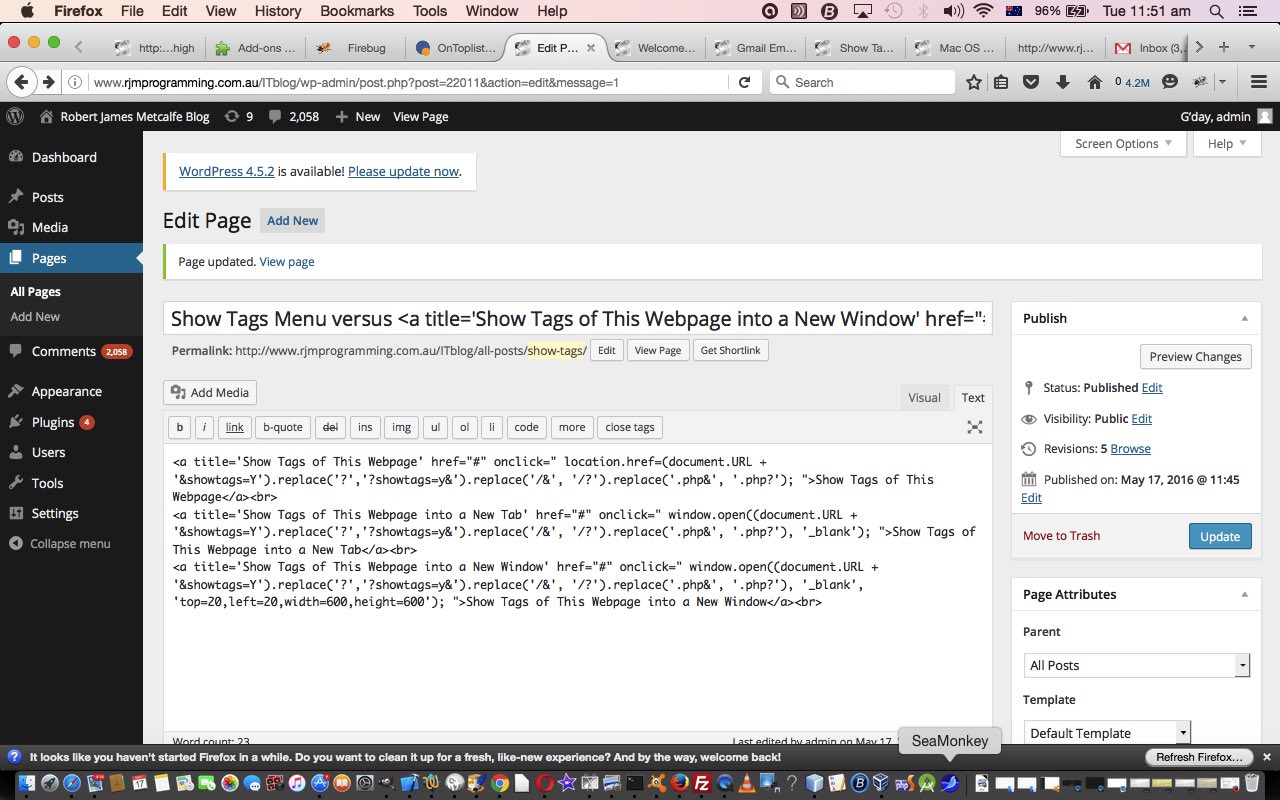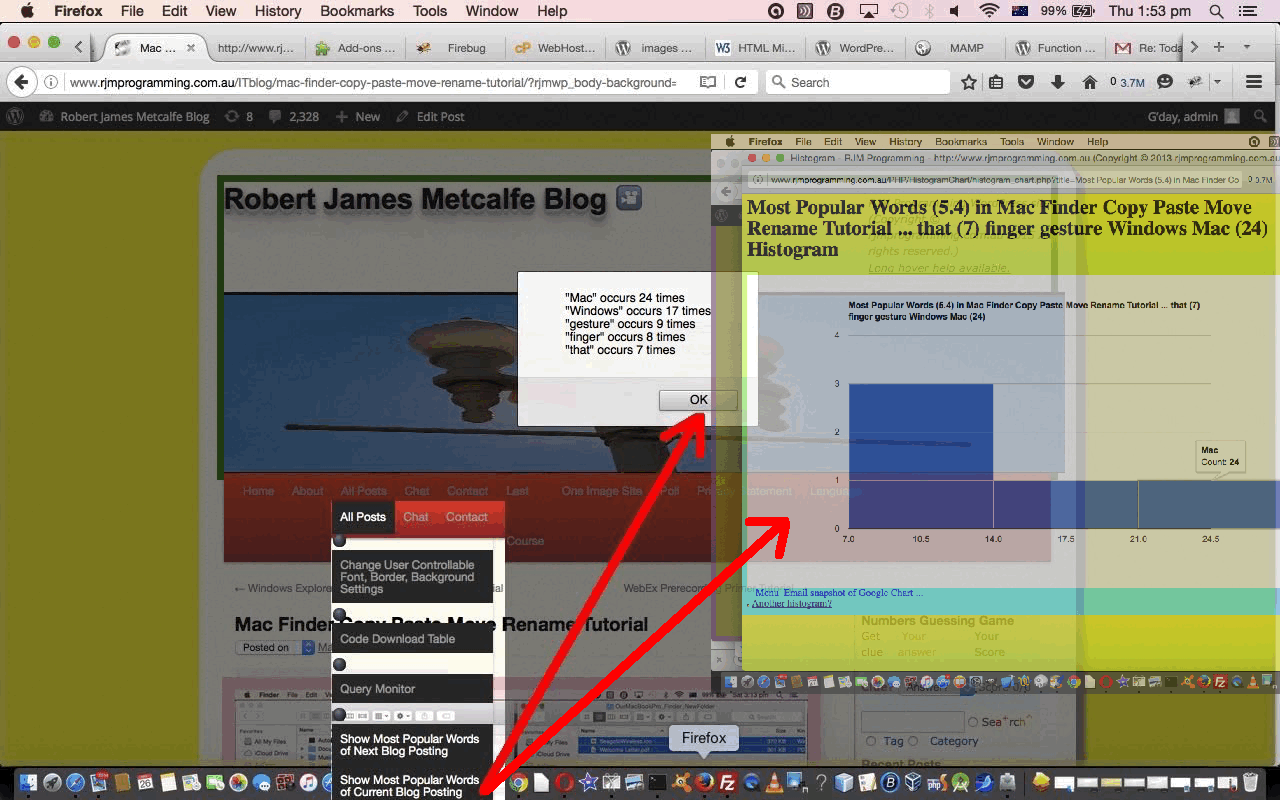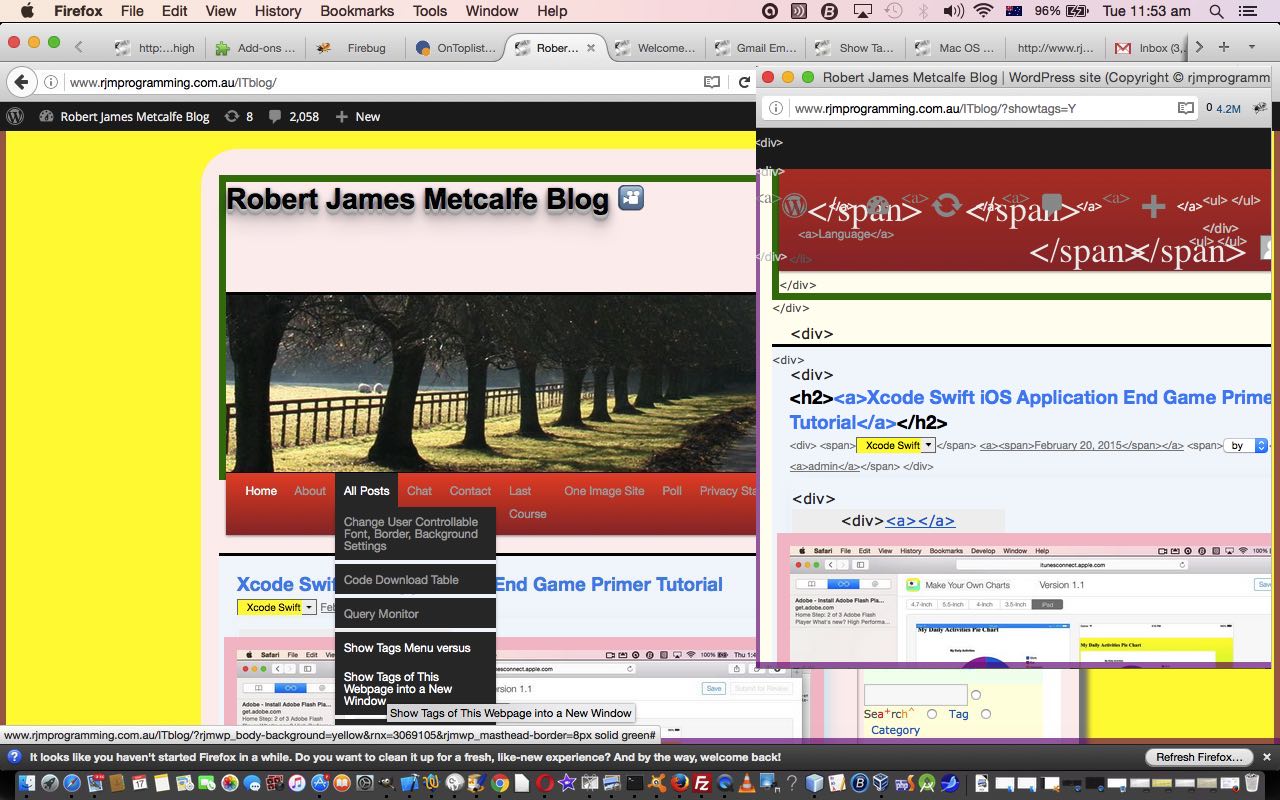If you are a regular reader of this blog, you’ll know one of the favourite software integrations we like to interface with is Google Charts, and the lead yesterday’s WordPress Content Most Popular Words Primer Tutorial as shown below, was, to us, a “promising start” but a disappointing “end game”, shall we say. Just a puny Javascript alert window? Actually “puny” is a bit strong a word to use, as the alert box is a very useful tool in the armoury of many a programmer, but just this, for all that coding effort of yesterday? Nine hundred and ninety nine times “no”. Plus today’s makes … 999 + 1 … oh yeh … 1000 times “no”.
So which Google Chart suits? This is often the issue to do with Google Chart usage. There are design choices to do with both data and aesthetics. We’ve plumped for the Histogram Chart today, as the exercise feels like a poll, or tallying exercise, to us.
Okay, the tallying hard work was done yesterday, and it is today’s job to construct the URL for one of our Google Chart Histograms we’ve interfaced to programmatically with our PHP coded histogram_chart.php that you can try for yourself with this live run link.
This involved … you guessed it … tweaking WordPress TwentyTen theme’s good ol’ header.php from yesterday …
<head>
// Lots of initializations
// Most common words on current post ... RJM Programming ... May, 2016
var histogramurl='';
var hwordlist='';
var thecwords="";
var thetwords="<?php echo str_replace(' | Robert Metcalfe Blog','',str_replace('Robert James Metcalfe','Robert Metcalfe',wp_title( '|', false, 'right' ))); ?>";
var fivething=5;
var minwl=4;
if (document.URL.indexOf('workwithcontent') != -1) {
var qwpo=document.URL.split('workwithcontent');
var xqwpo=qwpo[1].replace('=','').replace('+','').split('.');
if (qwpo[1].replace('=','').substring(0,1) == '+') histogramurl=' ';
if (xqwpo[0] != '') {
fivething=eval(xqwpo[0].replace('+',''));
if (xqwpo.length > 1) {
var prexxqwpo=xqwpo[1].split('#');
var xxqwpo=prexxqwpo[0].split('&');
minwl=eval(xxqwpo[0]);
}
}
<?php
if (strpos($post->post_content, "<hr") !== false) {
$xbitskw=explode(">", substr($post->post_content,0,strpos($post->post_content, "<hr")));
} else {
$xbitskw=explode(">", $post->post_content);
}
$xpostkws="";
$hurl="";
$xmysep="";
for ($jk=1; $jk<sizeof($xbitskw); $jk++) {
$xthiskw=explode("<", $xbitskw[$jk]);
if (strpos($xthiskw[0],">") === false && $xthiskw[0] != "") $xpostkws.=$xmysep . str_replace("\r"," ", str_replace("\n"," ", str_replace("\r\n"," ", str_replace('"', ' ', $xthiskw[0]))));
$xmysep=" ";
}
$xxourt=wp_title( '|', false, 'right' );
echo " \n thetwords=\"" . str_replace(' | Robert Metcalfe Blog','',str_replace('Robert James Metcalfe','Robert Metcalfe',$xxourt)) . "\"; \n";
echo " \n thecwords=\"" . str_replace(' | Robert Metcalfe Blog','',str_replace('Robert James Metcalfe','Robert Metcalfe',$xxourt)) . " " . $xpostkws . "\"; \n";
?>
var hblurbis='', negoff=0;
var huhacc=nthMostCommon(eval(100 + fivething));
var ksofar=0, isofar=0, lasthsuff='';
while (ksofar < fivething && isofar < huhacc.length) {
negoff=0;
if (huhacc[isofar].word.substring(0,1) >= 'A' && huhacc[isofar].word.substring(0,1) <= 'Z') negoff=-1;
if ((huhacc[isofar].word + '~').indexOf(',~') != -1) huhacc[isofar].word=(huhacc[isofar].word + '~').replace(',~','');
if (huhacc[isofar].word.trim() != '' && huhacc[isofar].word.indexOf('<') == -1 && huhacc[isofar].word.indexOf('&') == -1 && huhacc[isofar].word.indexOf('<') == -1 && huhacc[isofar].word.indexOf('(') == -1 && huhacc[isofar].word.indexOf('=') == -1 && huhacc[isofar].word.indexOf('[') == -1 && eval(huhacc[isofar].word.length) >= eval(negoff + minwl)) {
hblurbis+='"' + huhacc[isofar].word + '" occurs ' + huhacc[isofar].occurences + ' times ' + String.fromCharCode(10);
if (histogramurl != '') {
lasthsuff=" (" + huhacc[isofar].occurences + ")";
if (histogramurl == ' ') {
hwordlist=huhacc[isofar].word.replace(/'/g,"`") + lasthsuff;
histogramurl=" , [~" + huhacc[isofar].word.replace(/'/g,"`") + "~," + huhacc[isofar].occurences + "]";
} else {
hwordlist=huhacc[isofar].word.replace(/'/g,"`") + " " + hwordlist;
histogramurl+=" , [~" + huhacc[isofar].word.replace(/'/g,"`") + "~," + huhacc[isofar].occurences + "]";
}
}
ksofar++;
}
isofar++;
}
hwordlist=hwordlist.replace(" ", lasthsuff + " ");
setTimeout(mcAndThen, 2000);
}
function gohmnow(hmany, wlenis) {
var wsuffis="+5.4";
if (hmany == "" && wlenis == "") {
wsuffis=prompt("Separate by . the number of " + thetwords + " most used words to show and the minumum length of word (capital letter start adds one) ... leaving the '+' in shows histogram", wsuffis);
if (wsuffis == null) wsuffis="+5.4";
var pdsa=wsuffis.split('.');
if (pdsa.length > 1) {
hmany=wsuffis;
} else {
hmany=pdsa[0];
}
}
if (hmany.indexOf('.') != -1) {
wsuffis=hmany;
} else {
if (eval(hmany) < 0) {
wsuffis="5.";
} else {
wsuffis=hmany + ".";
}
if (wlenis == "") {
wsuffis+="4";
} else if (eval(wlenis) < 0) {
wsuffis+="4";
} else {
wsuffis+=wlenis;
}
}
var prehis=document.URL.split('#');
var pprehis=prehis[0].split('?');
if (pprehis.length == 1) {
location.href=pprehis[0].replace('workwithcontent','workXwithXcontent').replace(/content=+/g,'content=') + '?workwithcontent=' + wsuffis;
} else {
location.href=pprehis[0] + '?' + pprehis[1].replace('workwithcontent','workXwithXcontent').replace(/content=+/g,'content=') + '&workwithcontent=' + wsuffis;
}
}
function mcAndThen() {
if (histogramurl.indexOf(',') != -1) {
window.open("http://www.rjmprogramming.com.au/PHP/HistogramChart/histogram_chart.php?title=Most Popular Words (" + ("" + fivething).replace('+','') + '.' + minwl + ") in " + thetwords + " ... " + (hwordlist) + "&onclick=y&task=Word&desc=Count&data=" + (histogramurl), "_blank", "top=50,left=50,width=900,height=800");
histogramurl='';
setTimeout(mcAndThen, 2000);
} else {
alert(hblurbis);
}
}
function nthMostCommon(ammount) { // thanks to http://stackoverflow.com/questions/6565333/using-javascript-to-find-most-common-words-in-string
var wordsArray = thecwords.split(/\s/);
var wordOccurrences = {}
for (var i = 0; i < wordsArray.length; i++) {
wordOccurrences['_'+wordsArray[i]] = ( wordOccurrences['_'+wordsArray[i]] || 0 ) + 1;
}
var result = Object.keys(wordOccurrences).reduce(function(acc, currentKey) {
/* you may want to include a binary search here */
for (var i = 0; i < ammount; i++) {
if (!acc[i]) {
acc[i] = { word: currentKey.slice(1, currentKey.length), occurences: wordOccurrences[currentKey] };
break;
} else if (acc[i].occurences < wordOccurrences[currentKey]) {
acc.splice(i, 0, { word: currentKey.slice(1, currentKey.length), occurences: wordOccurrences[currentKey] });
if (acc.length > ammount)
acc.pop();
break;
}
}
return acc;
}, []);
return result;
}
And so we like it when software “jigsaw” pieces get interfaced and turn into …
- practically useful functionality … and to a lesser extent …
- something more aesthetically pleasing
Previous relevant WordPress Content Most Popular Words Primer Tutorial is shown below.
Today’s new WordPress functionality for our TwentyTen themed blog website looks back at a lot of the discoveries of WordPress Emoji Prefixed Submenu Primer Tutorial as shown below, in that we again make use of an Add Page submenu scenario where the submenu’s title has in it an HTML a tag link, for dynamic viewing purposes.
Guess we could call this new functionality “gist” because it is designed to give the user a “drill down” method to see what are the “keywords”, perhaps, involved with the current blog posting being presented.
Today’s work uses WordPress’s codex coding we last talked about with Search Engine Optimization Meta Keywords Primer Tutorial, specifically its …
$post->post_content
… to add the bold code to WordPress TwentyTen theme’s good ol’ header.php … and we apologize for sounding like a broken record …
<head>
// Lots of initializations
// Most common words on current post ... RJM Programming ... May, 2016
var thecwords="";
var fivething=5;
var minwl=4;
if (document.URL.indexOf('workwithcontent') != -1) {
var qwpo=document.URL.split('workwithcontent');
var xqwpo=qwpo[1].replace('=','').split('.');
if (xqwpo[0] != '') {
fivething=eval(xqwpo[0]);
if (xqwpo.length > 1) {
var prexxqwpo=xqwpo[1].split('#');
var xxqwpo=prexxqwpo[0].split('&');
minwl=eval(xxqwpo[0]);
}
}
<?php
if (strpos($post->post_content, "<hr") !== false) {
$xbitskw=explode(">", substr($post->post_content,0,strpos($post->post_content, "<hr")));
} else {
$xbitskw=explode(">", $post->post_content);
}
$xpostkws="";
$xmysep="";
for ($jk=1; $jk<sizeof($xbitskw); $jk++) {
$xthiskw=explode("<", $xbitskw[$jk]);
if (strpos($xthiskw[0],">") === false && $xthiskw[0] != "") $xpostkws.=$xmysep . str_replace("\r"," ", str_replace("\n"," ", str_replace("\r\n"," ", str_replace('"', ' ', $xthiskw[0]))));
$xmysep=" ";
}
$xxourt=wp_title( '|', false, 'right' );
echo " \n thecwords=\"" . str_replace(' | Robert James Metcalfe Blog','',$xxourt) . " " . $xpostkws . "\"; \n";
?>
var hblurbis='', negoff=0;
var huhacc=nthMostCommon(eval(100 + fivething));
var ksofar=0, isofar=0;
while (ksofar < fivething && isofar < huhacc.length) {
negoff=0;
if (huhacc[isofar].word.substring(0,1) >= 'A' && huhacc[isofar].word.substring(0,1) <= 'Z') negoff=-1;
if (huhacc[isofar].word.trim() != '' && huhacc[isofar].word.indexOf('<') == -1 && huhacc[isofar].word.indexOf('&') == -1 && huhacc[isofar].word.indexOf('=') == -1 && huhacc[isofar].word.indexOf('[') == -1 && eval(huhacc[isofar].word.length) >= eval(negoff + minwl)) {
hblurbis+='"' + huhacc[isofar].word + '" occurs ' + huhacc[isofar].occurences + ' times ' + String.fromCharCode(10);
ksofar++;
}
isofar++;
}
setTimeout(mcAndThen, 2000);
}
function gohmnow(hmany, wlenis) {
var wsuffis="5.4";
if (hmany == "" && wlenis == "") {
wsuffis=prompt("Separate by . the number of current Blog Posting most used words to show and the minumum length of word (capital letter start adds one)", wsuffis);
if (wsuffis == null) wsuffis="5.4";
var pdsa=wsuffis.split('.');
if (pdsa.length > 1) {
hmany=wsuffis;
} else {
hmany=pdsa[0];
}
}
if (hmany.indexOf('.') != -1) {
wsuffis=hmany;
} else {
if (eval(hmany) < 0) {
wsuffis="5.";
} else {
wsuffis=hmany + ".";
}
if (wlenis == "") {
wsuffis+="4";
} else if (eval(wlenis) < 0) {
wsuffis+="4";
} else {
wsuffis+=wlenis;
}
}
var prehis=document.URL.split('#');
var pprehis=prehis[0].split('?');
if (pprehis.length == 1) {
location.href=pprehis[0] + '?workwithcontent=' + wsuffis;
} else {
location.href=pprehis[0] + '?' + pprehis[1] + '&workwithcontent=' + wsuffis;
}
}
function mcAndThen() {
alert(hblurbis);
}
function nthMostCommon(ammount) { // thanks to http://stackoverflow.com/questions/6565333/using-javascript-to-find-most-common-words-in-string
var wordsArray = thecwords.split(/\s/);
var wordOccurrences = {}
for (var i = 0; i < wordsArray.length; i++) {
wordOccurrences['_'+wordsArray[i]] = ( wordOccurrences['_'+wordsArray[i]] || 0 ) + 1;
}
var result = Object.keys(wordOccurrences).reduce(function(acc, currentKey) {
/* you may want to include a binary search here */
for (var i = 0; i < ammount; i++) {
if (!acc[i]) {
acc[i] = { word: currentKey.slice(1, currentKey.length), occurences: wordOccurrences[currentKey] };
break;
} else if (acc[i].occurences < wordOccurrences[currentKey]) {
acc.splice(i, 0, { word: currentKey.slice(1, currentKey.length), occurences: wordOccurrences[currentKey] });
if (acc.length > ammount)
acc.pop();
break;
}
}
return acc;
}, []);
return result;
}
… that works in conjunction with the new Add Page submenu off the All Posts menu, that looks like below …

You’ll see in the code above the great help we got from this useful link … thanks heaps.
Maybe it gives you ideas for something menulike on a WordPress blog, somewhere out there, on the net.
Previous relevant WordPress Emoji Prefixed Submenu Primer Tutorial is shown below.
The fact that we find scope for so many CSS improvements and ideas around the menu system of our WordPress blog’s menu “Add Page” area and its submenus, is an indication of good and flexible web design, as we recently also saw with WordPress Show HTML Tags Primer Tutorial … thanks, WordPress!
Today we use PHP driven CSS to try to relax you users when you click on a menu and see a submenu “drop” down. Think, psychologically, you calm down a bit, here, if there is some extra space introduced … is an UX (user experience) opinion of mine, and you may well have a different one. Perhaps my opinion is swayed by the usual UX weakness we have about wanting to tell users as much as possible, and cramming things up … well, this morning, Nala told me there’d be “no more of that” … her exact woofs … and so … we digress, but … do you remember WordPress Bullet Point CSS Styling Emoji Tutorial? Today, we just build on the WordPress TwentyTen theme’s good ol’ header.php logic for that PHP driven CSS work to use the same techniques on a different CSS selection criteria … and so you see more WordPress design foresight, giving us lots of HTML classes to “hang our hats on” … merci, WordPress.
And how did we come by the discovery of these new CSS selection criteria? If you are a regular reader, we’d forgive you if you immediately blurted out Firefox’s FireBug add-on, and it is true that it’s hard to resist, but, today, perhaps you can see in today’s tutorial picture, a faint outline of Safari’s “out of the box” Web Inspector product that can help with this type of CSS investigation work, as well.
It’s not the science of green leaved piquancy exactly.
… but more the science of the fabulous CSS functionality involving :before and :after (selectors) and content: (property) usage … as you can surmise by the simplicity of the bold changes to WordPress TwentyTen theme’s good ol’ header.php below …
$wsarray = array("", "01F311", "0026F3", "0026BD", "00263C", "00263D", "00263E", "01F311", "0026F3", "0026BD", "0026f5",
"\xF0\x9F\x91\xA0", "\xF0\x9F\x91\x93", "\xF0\x9F\x90\x98", "\xF0\x9F\x90\x92", "\xF0\x9F\x8E\x89",
"\xF0\x9F\x8D\xB0", "\xF0\x9F\x8D\xA9", "\xF0\x9F\x8D\xA8", "\xF0\x9F\x8D\xA7", "\xF0\x9F\x8D\xA3",
"\xF0\x9F\x8D\xB1", "\xF0\x9F\x8E\x88", "\xF0\x9F\x8E\xA7", "\xF0\x9F\x8E\xA8", "\xF0\x9F\x8E\xB5",
"\xF0\x9F\x8F\x88", "\xF0\x9F\x90\x99", "\xF0\x9F\x90\x9E", "\xF0\x9F\x90\xB6", "\xF0\x9F\x90\xBC",
"\xF0\x9F\x90\xBE", "\xF0\x9F\x93\x8A", "\xF0\x9F\x93\xA2", "\xF0\x9F\x91\xBC", "\xF0\x9F\x90\xAB",
"\xF0\x9F\x90\xA8", "\xF0\x9F\x90\x97", "\xF0\x9F\x8F\x80", "\xF0\x9F\x8E\xB7", "\xF0\x9F\x8E\xA9",
"\xF0\x9F\x8D\xAE", "\xF0\x9F\x8D\x92", "\xF0\x9F\x8F\x80", "\xF0\x9F\x8C\x88", "\xF0\x9F\x9A\xB2",
"\xF0\x9F\x9A\xA2", "\xF0\x9F\x9A\x99", "\xF0\x9F\x9A\x87", "\xF0\x9F\x9A\x8F", "\xF0\x9F\x9A\xA7",
"\xF0\x9F\x9A\xAA", "\xF0\x9F\x9A\x83", "\xF0\x9F\x9A\x87", "\xF0\x9F\x98\x81", "\xF0\x9F\x98\x82",
"\xF0\x9F\x98\xB8", "\xF0\x9F\x9A\x92", "\xF0\x9F\x9A\x87", "\xF0\x9F\x9B\x80", "\xF0\x9F\x8C\xB4",
"\xF0\x9F\x8C\xB5", "\xF0\x9F\x8C\xB7", "\xF0\x9F\x8C\x9F", "\xF0\x9F\x8C\xBD", "\xF0\x9F\x8C\xBE",
"\xF0\x9F\x8D\x84", "\xF0\x9F\x8D\xB7", "\xF0\x9F\x8D\x8F", "\xF0\x9F\x8D\x9F", "\xF0\x9F\x8D\xB5",
"\xF0\x9F\x8C\x89", "\xF0\x9F\x8C\x8A", "\xF0\x9F\x8C\x8B", "\xF0\x9F\x8C\x87", "\xF0\x9F\x8C\x86",
"\xF0\x9F\x8C\x81", "\xF0\x9F\x8C\x82", "\xF0\x9F\x8C\x82", "\xF0\x9F\x8C\x83", "\xF0\x9F\x8C\x84",
"\xE2\x9B\xAA", "\xE2\x9B\xB2", "\xE2\x9B\xBA", "\xE2\x9B\x83", "\xF0\x9F\x9A\x80",
"\xF0\x9F\x97\xBB", "\xF0\x9F\x97\xBC", "\xF0\x9F\x97\xBD", "\xF0\x9F\x97\xBF", "\xF0\x9F\x90\xA7",
"\xF0\x9F\x99\x8B", "\xF0\x9F\x99\x88", "\xF0\x9F\x99\x89", "\xF0\x9F\x99\x8C", "\xF0\x9F\x98\x96");
$ws = rand(0, (sizeof($wsarray) - 1));
$cs = rand(0, 10);
$csarray = array("black", "red", "blue", "purple", "maroon", "teal", "brown", "orange", "olive", "lime", "green");
if ($wsarray[$ws] != "") {
$wschild = rand(0, (sizeof($wsarray) - 1)); // page submenu spacing accentuation
$cschild = rand(0, 10);
echo "
ul.children li.page_item:before {
color: " . $csarray[$cschild] . ";
content: '\\" . $wsarray[$wschild] . " \\0000a0';
}
ul.children li.page_item:after {
content: no-close-quote;
}
ul.noclass {
list-style: none;
}
ul.noclass li:before {
list-style: none;
float: left;
margin-left: -15px;
color: " . $csarray[$cs] . ";
content: '\\" . $wsarray[$ws] . " \\0000a0';
font-size: 1.2em;
font-weight: bold;
}
// etcetera etcetera etcetera
";
It’s not EXACTLY relevant, but doesn’t it make you feel like singing Green Acres is the place to be … ?
All in all … gracias, WordPress. Realmente realmente realmente pensamos que hay que mantener esto en marcha.
Previous relevant WordPress Show HTML Tags Primer Tutorial is shown below.
We’ve got one new concept and one concept revisited today with our work on some WordPress Blog functionality to allow users to show the HTML coding behind some of the HTML elements of the RJM Programming Blog webpage of interest. Say some because not all HTML elements lend themselves to allowing the functionality we’ve used to display the HTML involved. It is really only those HTML elements where their [element].innerHTML components can be displayable text that will show the HTML coding for today’s new functionality … even so, we think this could be a useful learning tool for users wanting to get ideas of what HTML elements go to make up what webpage look.
So today’s new concept, at least in relation to this blog’s postings from the past, is that it hadn’t occurred to us until today that the …
- WordPress TwentyTen theme’s top menu is constructed in such a way as to allow you to put “intelligence” into the “Add Page” Title that you enter … in other words you can include into the “Add Page” Title an HTML a tag, for example, that performs Javascript there and then on the webpage you are currently on, rather than navigating to a new “Add Page” menu page … which is of great interest to us with today’s work, because the user is likely to be reading a webpage of interest, now, that they want to see the internal HTML coding for, compared for them, in a new popup (window.open()) webpage, rather than seeing this for the “Add Page” menu webpage (we consider less interesting, but we’ll still allow in as your functionality usage choice)

… and, as we’ve talked about before, last, at this blog with … - WordPress Bullet Point CSS Styling Emoji Tutorial reminded us of the fabulous CSS functionality involving :before and :after (selectors) and content: (property) usage, which we put to use here … those of you into editing XML and using Epic may be “right at home” with these ideas … though what we do here with HTML is nothing as involved as Epic does for XML … we’re just into presenting a readonly guide, for curiosity’s sake
So what needed to change in good ol’ (TwentyTen theme’s) header.php to do this pretty simple change …
</script>
<?php
if (isset($_GET['showtags'])) {
echo "<link href='//www.rjmprogramming.com.au/HTMLCSS/showtags.css' rel='stylesheet' type='text/css'>";
}
?>
</head>
… just asking for the address bar URL to contain a (PHP $_GET[‘showtag’]) showtag= part to the webpage call. It’s not the science of green leaved piquancy exactly.
And so if you want to see what we have here with extra HTML tagging shown, in a new popup window, try this live run link, and “chow for now”.
If this was interesting you may be interested in this too.
If this was interesting you may be interested in this too.
If this was interesting you may be interested in this too.
If this was interesting you may be interested in this too.






